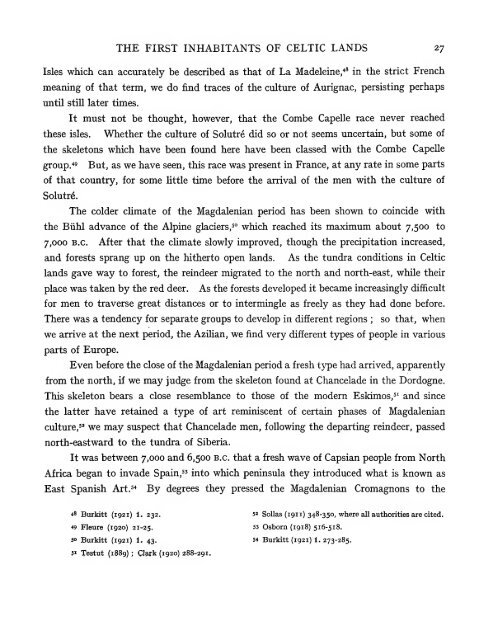The bronze age and the Celtic world - Universal History Library
The bronze age and the Celtic world - Universal History Library
The bronze age and the Celtic world - Universal History Library
You also want an ePaper? Increase the reach of your titles
YUMPU automatically turns print PDFs into web optimized ePapers that Google loves.
THE FIRST INHABITANTS OF CELTIC LANDS 27<br />
Isles which can accurately be described as that of La Madeleine/* in <strong>the</strong> strict French<br />
meaning of that term, we do find traces of <strong>the</strong> culture of Aurignac, persisting perhaps<br />
until stiU later times.<br />
It must not be thought, however, that <strong>the</strong> Combe Capelle race never reached<br />
<strong>the</strong>se isles. Whe<strong>the</strong>r <strong>the</strong> culture of Solutre did so or not seems uncertain, but some of<br />
<strong>the</strong> skeletons which have been found here have been classed with <strong>the</strong> Combe Capelle<br />
group.« But, as we have seen, this race was present in France, at any rate in some parts<br />
of that country, for some Uttle time before <strong>the</strong> arrival of <strong>the</strong> men with <strong>the</strong> culture of<br />
Solutre.<br />
<strong>The</strong> colder chmate of <strong>the</strong> Magdalenian period has been shown to coincide with<br />
<strong>the</strong> Biihl advance of <strong>the</strong> Alpine glaciers,^" which reached its maximum about 7,500 to<br />
7,000 B.C. After that <strong>the</strong> climate slowly improved, though <strong>the</strong> precipitation increased,<br />
<strong>and</strong> forests sprang up on <strong>the</strong> hi<strong>the</strong>rto open l<strong>and</strong>s. As <strong>the</strong> tundra conditions in <strong>Celtic</strong><br />
l<strong>and</strong>s gave way to forest, <strong>the</strong> reindeer migrated to <strong>the</strong> north <strong>and</strong> north-east, while <strong>the</strong>ir<br />
place was taken by <strong>the</strong> red deer. As <strong>the</strong> forests developed it became increasingly difficult<br />
for men to traverse great distances or to intermingle as freely as <strong>the</strong>y had done before.<br />
<strong>The</strong>re was a tendency for separate groups to develop in different regions ; so that, when<br />
we arrive at <strong>the</strong> next period, <strong>the</strong> Azilian, we find very different types of people in various<br />
parts of Europe.<br />
Even before <strong>the</strong> close of <strong>the</strong> Magdalenian period a fresh type had arrived, apparently<br />
from <strong>the</strong> north, if we may judge from <strong>the</strong> skeleton found at Chancelade in <strong>the</strong> Dordogne.<br />
This skeleton bears a close resemblance to those of <strong>the</strong> modern Eskimos,^' <strong>and</strong> since<br />
<strong>the</strong> latter have retained a type of art reminiscent of certain phases of Magdalenian<br />
culture,'* we may suspect that Chancelade men, following <strong>the</strong> departing reindeer, passed<br />
north-eastward to <strong>the</strong> tundra of Siberia.<br />
It was between 7,000 <strong>and</strong> 6,500 B.C. that a fresh wave of Capsian people from North<br />
Africa began to invade Spain," into which peninsula <strong>the</strong>y introduced what is known as<br />
East Spanish Art.'* By degrees <strong>the</strong>y pressed <strong>the</strong> Magdalenian Cromagnons to <strong>the</strong><br />
48 Burkitt (1921) 1. 232.<br />
« Fleure (1920) 21-25.<br />
5° Burkitt (1921) 1. 43.<br />
5' Testut (1889) ; Clark (1920) 288-291.<br />
5* Sollas (191 1) 348-350, where all authorities are cited.<br />
33 Osborn (1918) 516-518.<br />
54 Burkitt (1921) 1. 273-285.







